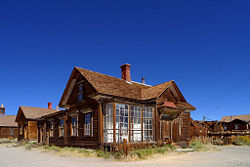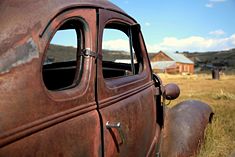Bodie, California
| Bodie, California | |
 |
|
| Coordinates: | |
| Country | United States |
|---|---|
| State | California |
| County | Mono |
| Founded | 1876 |
| Government | |
| - None | |
| Time zone | PST (UTC-8) |
| - Summer (DST) | PDT (UTC-7) |
| ZIP code | 93517 |
| Area code(s) | 760 |
| Website: Bodie State Historic Park | |
Bodie, California is a ghost town east of the Sierra Nevada mountain range in Mono County, California, United States, about 75 miles (120 km) southeast of Lake Tahoe. As Bodie Historic District, the U.S. Department of the Interior recognizes it as a National Historic Landmark. The ghost town has been administered by California State Parks since becoming a state historic park in 1962.
Contents |
Establishment
Bodie began as a mining camp of little note following the discovery of gold in 1859 by prospector W. S. Bodey (also spelled Body). That November, Bodey perished in a blizzard after making a supply trip to nearby Monoville.[1]
In 1876, the Standard Company discovered a profitable deposit of gold-bearing ore, which transformed Bodie from an isolated mining camp comprising a few prospectors and company employees to a Wild West boomtown. Rich discoveries in the adjacent Bodie Mine during 1878 attracted even more hopeful people. By 1880, Bodie had a population of 7 - 8,000. Over the years, Bodie's mines produced gold valued at more than $34 million.[2]

As a bustling gold mining center, Bodie had the amenities of larger towns, including two banks, a brass band, railroad, miner's and mechanic's unions, several newspapers, and a jail. At its peak 65 saloons lined Main Street, which was a mile long. Murders, shootouts, barroom brawls, and stagecoach holdups were regular occurrences.[3] Legend has it that a little girl, upon learning that her family was moving there, prayed one night, "Goodbye God, we are going to Bodie."[4] But a local editor claimed she had really prayed, "Good! By God, we are going to Bodie."
Gold bullion from the town's nine stamp mills was shipped to Carson City, Nevada by way of Aurora, Wellington and Gardnerville. Most shipments were accompanied by an armed guard. Once the bullion reached Carson City, it was delivered to the mint or sent by rail to the mint in San Francisco.
A first in electrical power

In 1893 the Standard Company built its own hydroelectric plant, located approximately 12.5 miles (20.1 km) away on Green Creek, above Bridgeport, California. The plant developed a maximum of 130 horsepower (97 kW) and 6,600 volts alternating current (AC) to power the company's 20-stamp mill. This pioneering installation is marked as one of the country's first transmissions of electricity over a long distance.
There were doubts about whether the electricity would reach Bodie. To be safe, the transmission line was run in a straight line from Green Creek. (Dead straight on the map; the line did not bore directly through mountains.)
Notable points about Bodie, CA

Bodie had a Chinatown, with several hundred Chinese residents at one point, and included a Taoist temple.
Bodie has a cemetery on the outskirts of town and a nearby mortuary, which is the only building in the town built of red brick three courses thick, most likely for insulation to keep the air temperature steady (cold winters, hot summers).
As with other remote mining towns, Bodie had a popular, though clandestinely important, red light district on the north end of town. From this is told the unsubstantiated story of Rosa May, a prostitute who, in the style of Florence Nightingale, came to the aid of the town menfolk when a serious epidemic struck the town at the height of its boom. She was credited with giving life-saving care to many, but was denied burial within the gates of the town cemetery, remaining a social outcast even to her death.
On Main Street stands the Miners Union Hall, which was the meeting place for labor unions and an entertainment center that hosted dances, concerts, plays, and school recitals. It now serves as a museum. The State Park's ranger station is located in one of the original homes on Green Street.
The Irish rockband U2 held a photoshoot in Bodie for their 1987 album The Joshua Tree.
Politics
In the state legislature Bodie is located in the 1st Senate District, represented by Republican Dave Cox, and in the 25th Assembly District, represented by Republican Tom Berryhill. Federally, Bodie is located in California's 25th congressional district, which has a Cook PVI of R +7[5] and is represented by Republican Buck McKeon.
Weather
Summers in Bodie are hot, but in winter, temperatures often plummet well below 0 °F (−18 °C)[6], and winds can sweep across the valley at close to 100 miles per hour (160 km/h). Nights remain cold even through the summer. Bodie has held the record for the number of coldest consecutive days in the nation. The harsh weather is due to a particular combination of high altitude (8,400 feet (2,600 m)) and a very exposed plateau, with little in the way of a natural surrounding wall to protect the long, flat piece of land from the elements. Plenty of firewood was needed to keep residents warm through the long winters. Bodie is above the timber line , so lumber had to be imported; both from Nevada and later Mono Mills, on the south shore of Mono Lake. The winter of 1878–1879 was particularly harsh and claimed the lives of many residents.
Authentic ghost town
| Bodie Historic District | |
|---|---|
| (U.S. National Historic Landmark District) | |
 |
|
| Nearest city: | Bridgeport, California |
| Built/Founded: | 1860 |
| Architect: | Unknown |
| Architectural style(s): | No Style Listed |
| Designated as NHL: | July 4, 1961[7] |
| Added to NRHP: | October 15, 1966[8] |
| NRHP Reference#: | 66000213 |
| Governing body: | State |
Though greatly reduced in prominence, Bodie held a permanent residency through most of the 20th century, even after a fire ravaged much of the downtown business district in 1932. Bodie is now an authentic Wild West ghost town. The town was designated a National Historic Landmark in 1961,[7][9] and in 1962 it became Bodie State Historic Park.
Today, Bodie is preserved in a state of arrested decay. Only a small part of the town survives. Visitors can walk the deserted streets of a town that once had a population of nearly 10,000 people. Interiors remain as they were left and stocked with goods. Bodie is open all year, but the long road that leads to it is usually closed in the winter due to heavy snowfall, so the most comfortable time to visit is during the summer months.
See also
- Ghost town
- List of California state parks
References
- ↑ Piatt, Michael H. (2003). Bodie: "The Mines Are Looking Well...". North Bay Books. ISBN 0972520058.
- ↑ Chesterman, Chapman, and Gray, Geology and Ore Deposits of the Bodie Mining District. California Division of Mines and Geology. Bulletin 206.
- ↑ McGrath, Roger D. Gunfights, Highwaymen & Vigilantes: Violence on the Frontier, University of California Press (1987).
- ↑ Delyser, Dydia (2003). "Good, by God, We are Going to Bodie". in Gary J. Hausladen. Western Place, American Myths. University of Nevada Press.
- ↑ "Will Gerrymandered Districts Stem the Wave of Voter Unrest?". Campaign Legal Center Blog. Retrieved on 2007-10-20.
- ↑ Average High/Low Temperatures for KTVL : Weather Underground
- ↑ 7.0 7.1 "Bodie Historic District". National Historic Landmark summary listing. National Park Service. Retrieved on 2008-06-16.
- ↑ "National Register Information System". National Register of Historic Places. National Park Service (2008-04-15).
- ↑ ____ (__, 19__), National Register of Historic Places Inventory-Nomination: ___NPS website down, fill this out later_______PDF (32 KB), National Park Service and Accompanying __ photos, exterior and interior, from 19__PDF (32 KB)
Further reading
- Cain, Ella M. (1956). The Story of Bodie. San Francisco: Fearon Publishers in cooperation with Mother Lode Press, Sonora, Calif.. OCLC 4238152.
- Calloway, R.A. (1979). Bodie State Historic Park: resource management plan, general development plan and environmental impact report. Sacramento: Calif. Dept. of Parks and Recreation. OCLC 21629664.
- Jackson, W.T. (1962). Historical material on the mining town of Bodie, California: a critical bibliography. Sacramento: California Division of Beaches and Parks. OCLC 58742626.
- Johnson, R.; Johnson, A (1967). The ghost town of Bodie, as reported in the newspapers of the day. Bishop, Calif: Printed and distributed by Chalfant Press for Sierra Media.. OCLC 1592631.
- McDonald, D. (1988). Bodie, boom town-gold town: the last of California's old-time mining camps. Las Vegas, Nev: Nevada Publications. OCLC 21384472.
- McGrath, Roger D. (1984). Gunfighters, Highwaymen & Vigilantes: Violence on the Frontier. Berkeley, CA: University of California Press. OCLC 123161918.
- Morse, T.I.; Joseph, L. (1990). Photographing Bodie: a photographer's guide to the ghost town of Bodie, California. Santa Barbara, Calif: Global Preservation Projects. OCLC 54961458.
- Piatt, Michael H. (2003). Bodie: "The Mines Are Looking Well . . .". El Sobrante, Calif: North Bay Books. OCLC 54109455.
- Retailers Protective Association (1880). Delinquent list of Virginia City, Gold Hill, Carson and Reno Nevada, and Bodie, California. OCLC 28163028.
- Smith, G.H. (1925). Bodie, the last of the old-time mining camps. San Francisco, Calif: California Historical Society. OCLC 78991456.
- Smith, H.L. (1934). The Bodie era the chronicles of the last old time mining camp. OCLC 58937388.
- Sprague, M. (2003). Bodie's gold: tall tales and true history from a California mining town. Reno: University of Nevada Press. OCLC 50803672.
- Wedertz, F.S. (1969). Bodie, 1859-1900. Bishop, Calif: Chalfant Press. OCLC 27440.
External links
- Bodie Foundation - A non-profit organization
- The latest research on Bodie
- Learn about and tour Bodie online at Bodie.com
- Bodie State Historic Park official website
- Quivik, Gold and Tailings: The Standard Mill at Bodie, California
- National Park Service: A History of Chinese Americans in California: Bodie Chinese American Community
- Story of Bodie - Stereoscopic Video Project
- Bodie in 1865 and recent photographs
|
||||||||||||||
|
||||||||||
